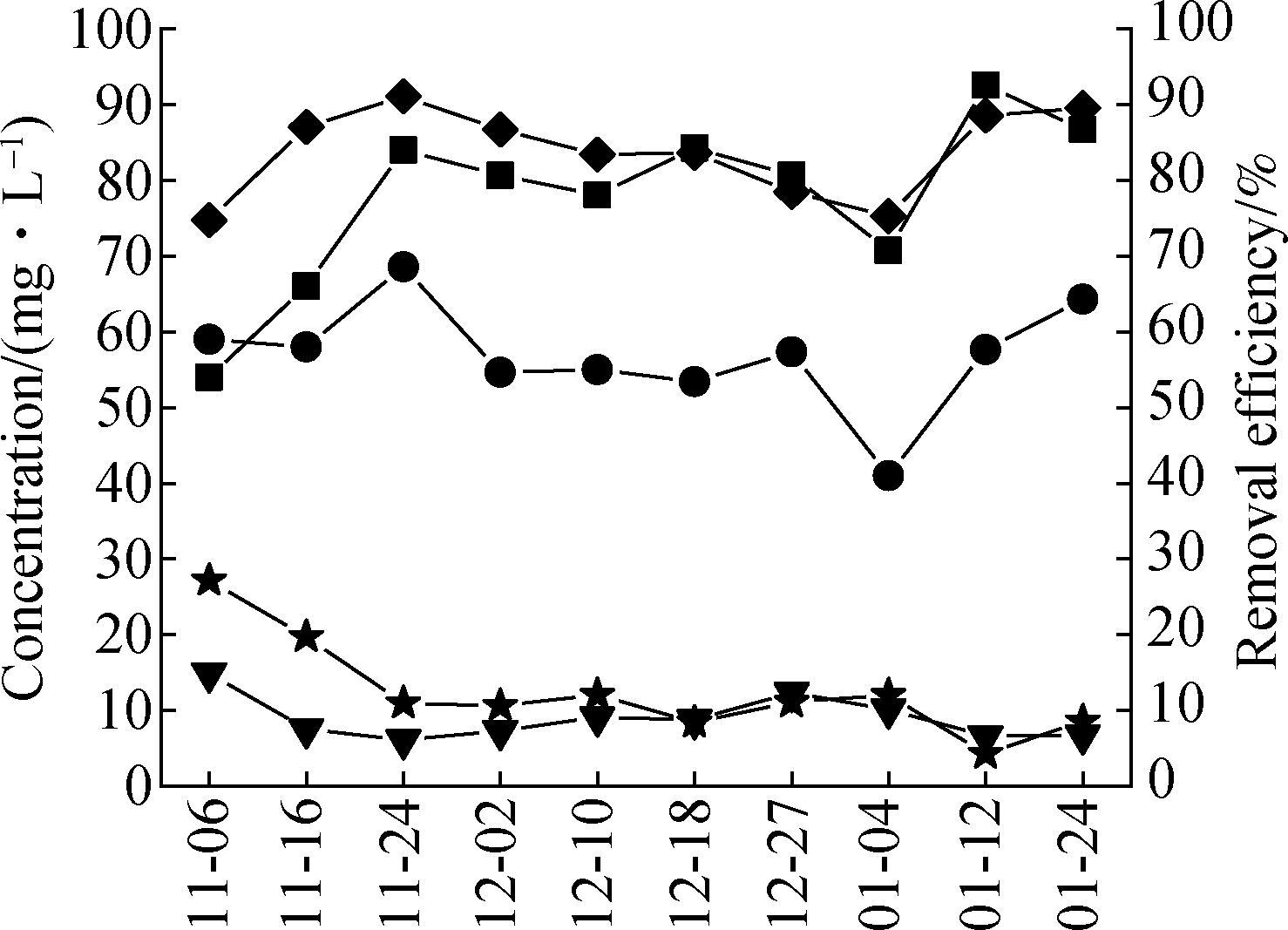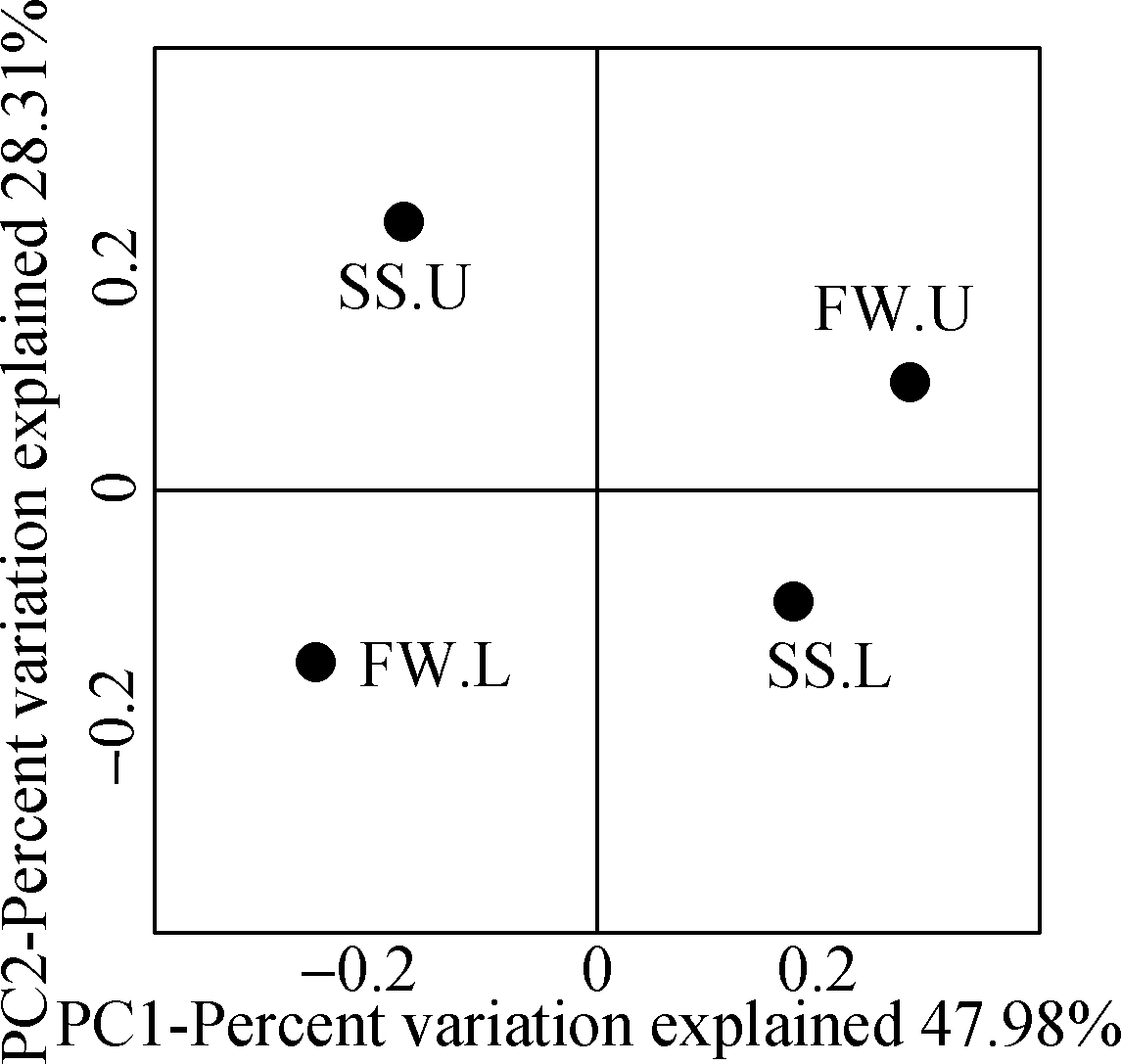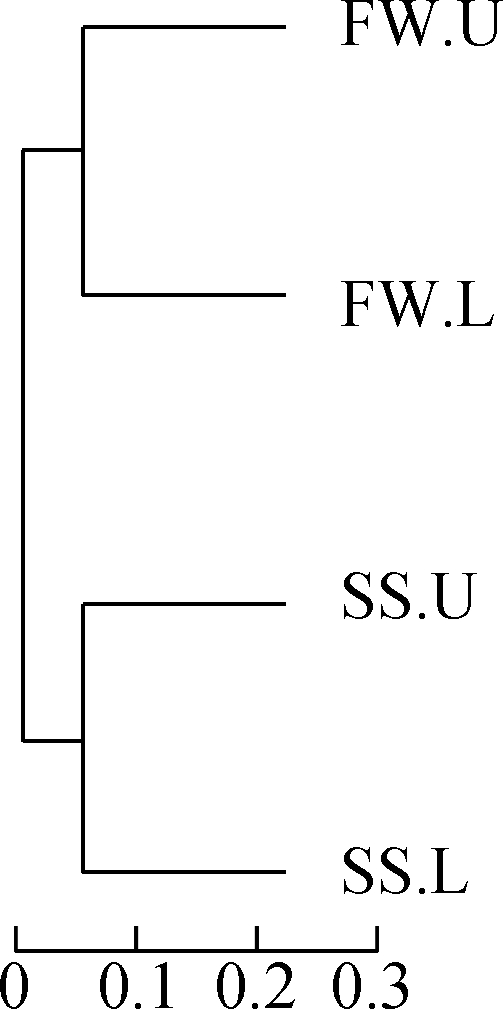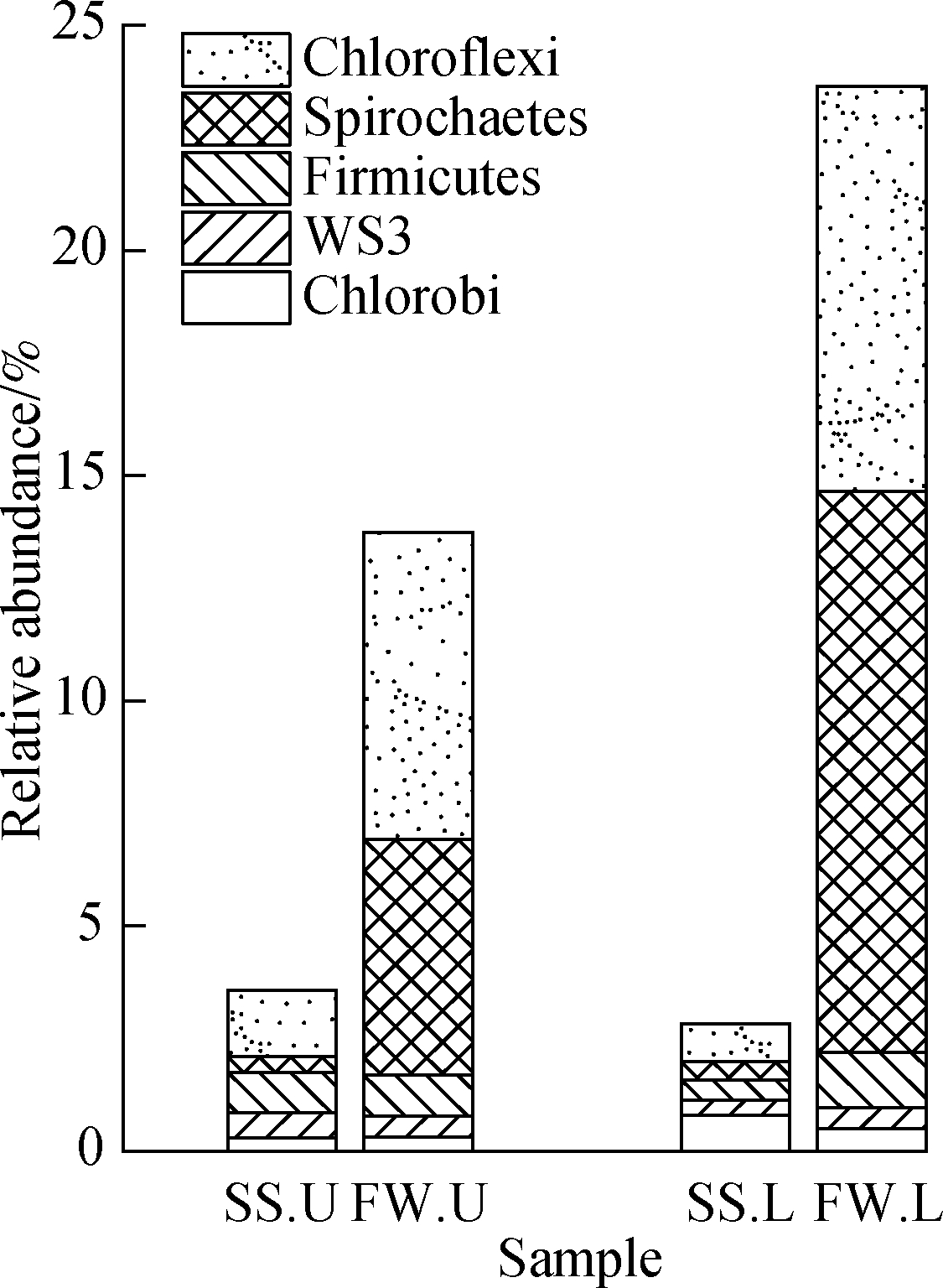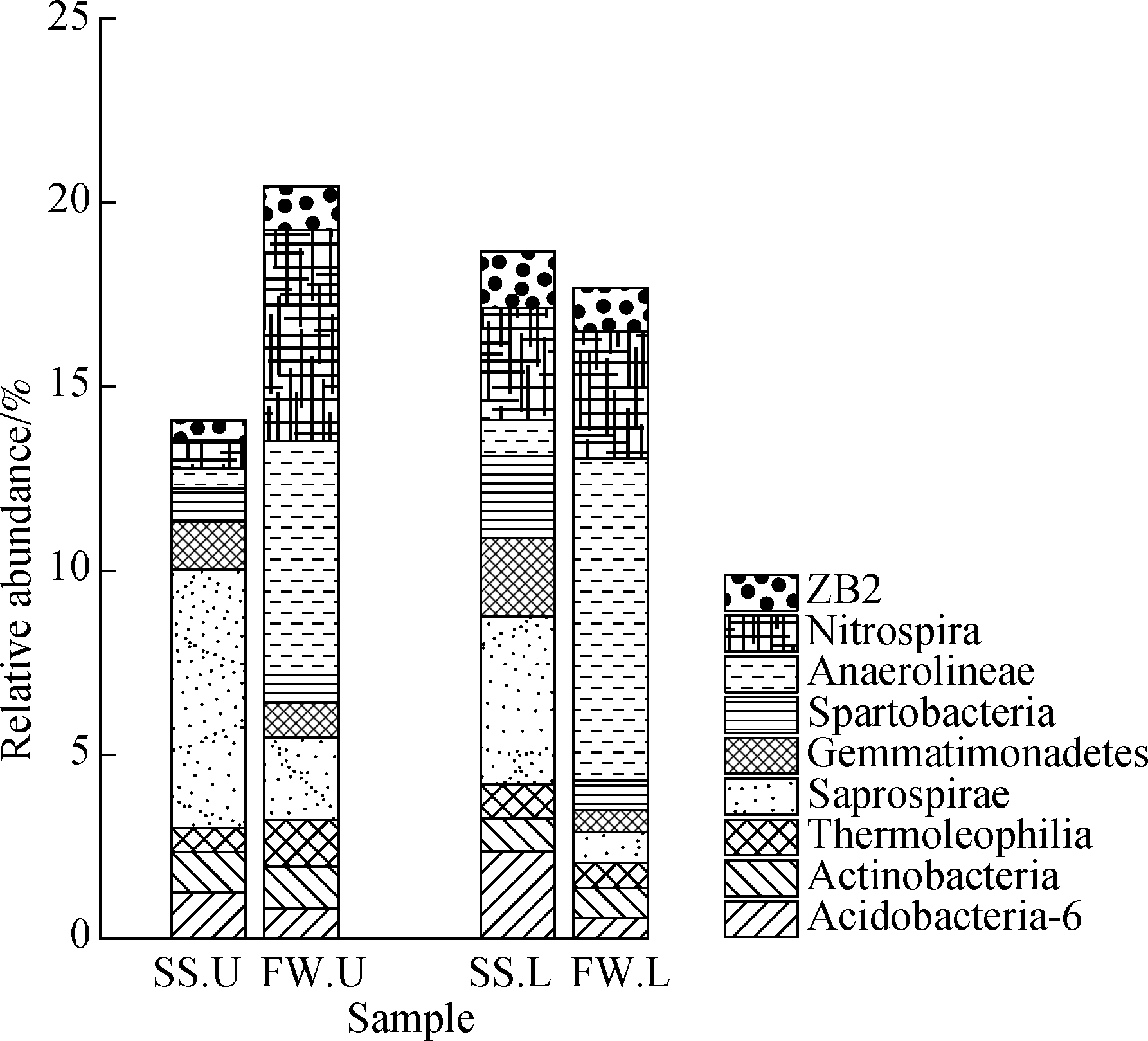Owing to its excellent antimicrobial activity, silver nanoparticle (Ag NP) is one of the most widely used nanomaterials with the highest degree of commercialization[1]. The widespread use of Ag NPs products has inevitably resulted in the release of Ag NPs into the land and water environment, most of which end up in the wastewater treatment systems[2]. Among these, constructed wetlands (CWs) are widely used because of their decentralized and cost-effective nature and environmentally friendliness that allow efficient removal of pollutants with the assistance of plants, microorganisms, and substrates through biological, physical, and chemical processes[3-4]. Therefore, the application of Ag NPs inevitably leads to their appearance in CWs, which further inhibits some microorganisms and reduces the efficiency of biological wastewater treatment[5-6].
Despite the knowledge of this problem, only a few studies have evaluated the effect of Ag NPs on the wastewater treatment performance of CWs in cold seasons. Especially in cold seasons, low temperature affects plant growth, physiology, and rhizosphere environmental condition as well as slows down the reaction rate for soil and aquatic microorganisms, thereby reducing both physical and biological activities in CWs, which lower the wastewater treatment ability[7-8]. With the aim of probing the feasibility of CWs for Ag NPs advanced wastewater treatment in cold seasons, the CW continued to be operated with synthetic wastewater containing 20 μg/L Ag NPs for approximately 300 d. The objectives of the present study were to probe the feasibility of CW for Ag NPs advanced wastewater treatment in the cold season and clarify the changes in the microbial community from the warm season to the cold season after long-term exposure to Ag NPs. The present long-term experiment results provide deep insights into the feasibility of CW for Ag NPs in the cold seasons and the changes in the microbial community to evaluate the performance and operation of CWs.
1 Materials and Methods
1.1 The experimental vertical flow CW system
The pilot-scale vertical flow CW (VFCW) was set up in the laboratory of Southeast University in Nanjing, Jiangsu Province, China. The diameter of the experimental wetland was 0.60 m, and the height was 1.00 m, of which the substrate height was 0.75 m. Meanwhile, the substrate frame structure of the wetland consisted of four layers. The upper layer contained 0.20 m soil, acquired from the nature environment of Nanjing. In the case of the plant in this wetland, Iris pseudacorus was planted, considering its greater capacity to remove pollutants. As for the operation of the wetland, the peristaltic pump (BT100-1F, Longer Pump Co., Ltd, China) was applied to provide continuous inflow, and the hydraulic loading rate was maintained at 0.1 min/d. Meanwhile, the hydraulic residence time was 59 h, and the water level was controlled at 2 cm below the soil layer. The other details of the CW mesocosm are available in our previous study[9].
1.2 Ag NPs suspension and synthetic wastewater
The Ag nanoparticles with the size of 10 to 40 nm coated with polyvinylpyrrolidone (PVP) were purchased from Huzheng Nano Technology Co., Ltd. in Shanghai. Based on the manufacturer’s instructions, the purity of Ag NPs was greater than 99.99%. The average particle size of Ag NPs was (24.4±8.2) nm. Meanwhile, dynamic light scattering analysis revealed that the average hydrated particle size of Ag NPs in dispersion was (58.1±2.4) nm, indicating that the Ag NPs were dispersed in the suspension without aggregation and were completely uniform.
The synthetic wastewater was designed to represent the effluent from a secondary biological reactor according to the actual effluent water quality. The theoretical concentrations of chemical oxygen demand (COD), total nitrogen (TN), ammonia nitrogen  and total phosphorus (TP) in synthetic wastewater were 50, 10, 7, and 1.5 mg/L, respectively. The details of the synthetic wastewater are described in our previous study[9].
and total phosphorus (TP) in synthetic wastewater were 50, 10, 7, and 1.5 mg/L, respectively. The details of the synthetic wastewater are described in our previous study[9].
1.3 Sampling and analysis
Before starting the experiment, the CW was fed with synthetic wastewater without Ag NPs for 6 months until the CW operation stabilized. During the last 30 d of this phase, the water quality parameters were measured. Then, the CW was continuously fed with synthetic wastewater containing 20 μg/L Ag NPs. The water quality parameters from March to July in the spring and summer seasons were measured, and this period was regarded as Phase SS[9]. In Phase SS, the average temperature of the water was 21.5 ℃. Next, the wetland continued to operate with synthetic wastewater containing 20 μg/L Ag NPs from November to January until the end of the experiment; the average temperature of the water during this time was 15.3 ℃. All water quality parameters were measured approximately once a week, according to the standard methods (APHA, 2005) during the period called Phase FW.
The actual contents of silver in the upper and lower soil layers were investigated at the later stage of the different phases in order to better understand the effect of Ag NPs on the soil microorganisms. Three sampling points were set up in the upper and lower soil layers to analyze the distribution of Ag NPs with a special wetland matrix sampler. After air-drying, the samples were filtered through 20-mesh sieves, mixed, and digested according to the US EPA method 3050B. The total Ag contents of different soil samples were detected through inductively coupled plasma atomic emission spectroscopy (ICP-AES) (ICAP 6300; Thermo Fisher Scientific, Waltham, MA, USA).
1.4 Microbial community
To understand the changes in the bacterial communities from the warm to cold seasons under the exposure of Ag NPs, the bacterial communities in the upper and lower soil layers were investigated at the end of Phase SS and Phase FW through Illumina high-throughput sequencing. The specific sampling time of Phases SS and FW was July 5th and January 24th, respectively. The upper soil samples were collected from 0 to 10 cm of the wetland soil layer, and the lower samples were collected from 10 to 20 cm. The genomic DNA extraction was performed using the Powersoil DNA Isolation Kit (Mobio Laboratories, Carlasbad, USA), according to the manufacturers’ instructions. Meantime, the extracted DNA was stored at -20 ℃ until further use. PCR amplification was conducted as previously described[6]. Pyrosequencing of different samples’ amplifications was conducted on the Illumina MiSeq platform by Shanghai Personalbio Technology Co., Ltd., China. The operational taxonomic units (OTUs) were used to cluster sequences by setting a 97% similarity using the QIIME software package, followed by the generation of the rarefaction curves, diversity indexes (Shannon and Simpson), and richness indexes (Chao1 and observed species) for each sample. Meantime, the relative abundances of the bacterial communities in different samples at different taxonomic ranks were revealed by the QIIME software package. Potential transformations of the bacterial community structure in different soil layers during the warm to cold seasons were illustrated using the principal coordinate analysis (PCoA) and the Unweighted Pair Group Method with Arithmetic Mean (UPGMA) methods.
1.5 Statistical analysis
The removal efficiencies and the mass removal rates of various pollutants were calculated using the following formula:
(1)
MR=0.1(Cin-Cout)
(2)
where RE is the removal efficiency of pollutants; MR is the mass removal rate of pollutants; Cin is the influent concentration of pollutants; Cout is the effluent concentration of pollutants.
All data were expressed as the mean standard deviation. Software SPSS 23.0 was used to analyze the variance (ANOVA) to test the significant difference between the results; p<0.05 was considered to indicate a statistically significant difference between the results. The linear regression relationships between the nutrient removal efficiencies of the soil layer and temperature were conducted with Software Origin 2017.
2 Results and Discussion
2.1 Nutrient removal effect of the VFCW
The influence of Ag NPs (20 μg/L) in low temperature on COD removal was evaluated. As shown in Fig.1(a), the maximum effluent concentration of COD was 12.33 mg/L in the cold seasons, indicating that the COD concentrations under the double-pressure could reach Level 1A of the People’s Republic of China’s Discharge Standard of Pollutants for municipal wastewater treatment plant (GB 18918—2002), according to the discharge limit value (50 mg/L). As shown in Tab.1, the average soil layer COD removal efficiency increased slightly from (73.6±4.5)% in warm seasons to (77.8±11.3)% in cold seasons, while the average soil layer COD mass removal rate increased slightly from (3.30±0.22) g/(m2·d) in warm seasons to (4.44±0.96) g/(m2·d) in cold seasons. The difference analysis (p>0.05) and linear regression relationship (R2=0.390) indicated that cold temperature had little effect on the removal capacity of COD in the soil layer under the exposure of Ag NPs.
The average TN-removal efficiency and the mass removal rate of the soil layer, and the average  removal efficiency and mass removal rate in cold seasons were significantly lower than those in the warm seasons (p<0.05) (see Tab.1). Meantime, as shown in Figs.1(b) and (c), the capacity of nitrogen removal continued to decrease conspicuously in cold seasons, indicating that low temperature could obviously reduce the capacity of nitrogen removal under long-term exposure to Ag NPs. Furthermore, the nitrogen removal efficiencies of the soil layer were positively correlated with temperature. The squared multiple correlation coefficients (R2(TN)=0.463, p<0.05;
removal efficiency and mass removal rate in cold seasons were significantly lower than those in the warm seasons (p<0.05) (see Tab.1). Meantime, as shown in Figs.1(b) and (c), the capacity of nitrogen removal continued to decrease conspicuously in cold seasons, indicating that low temperature could obviously reduce the capacity of nitrogen removal under long-term exposure to Ag NPs. Furthermore, the nitrogen removal efficiencies of the soil layer were positively correlated with temperature. The squared multiple correlation coefficients (R2(TN)=0.463, p<0.05;  p<0.05) were higher than those of COD (R2=0.390) and TP (R2=0.220), indicating that the reduction of the nitrogen removal capacity was mainly due to the temperature. It has been reported that the processes of ammonification, nitrification, and denitrification were found to be temperature-dependent in the wetlands[8]. In addition, the decay and dormancy of the plants at low temperatures could inhibit the assimilation of inorganic nitrogen[10]. As shown in Figs.1(b) and (c), the maximum effluent concentrations of TN and
p<0.05) were higher than those of COD (R2=0.390) and TP (R2=0.220), indicating that the reduction of the nitrogen removal capacity was mainly due to the temperature. It has been reported that the processes of ammonification, nitrification, and denitrification were found to be temperature-dependent in the wetlands[8]. In addition, the decay and dormancy of the plants at low temperatures could inhibit the assimilation of inorganic nitrogen[10]. As shown in Figs.1(b) and (c), the maximum effluent concentrations of TN and  in the cold seasons were 7.84 and 5.19 mg/L, respectively. This result indicated that TN concentrations at low temperature were less than 15 mg/L and could reach Level 1A (GB 18918—2002), but the
in the cold seasons were 7.84 and 5.19 mg/L, respectively. This result indicated that TN concentrations at low temperature were less than 15 mg/L and could reach Level 1A (GB 18918—2002), but the  concentration slightly exceeded the discharge standard (5 mg/L). As a result, under long-term Ag NPs exposure and at low temperature, the use of CW as an advanced water treatment is feasible in terms of nitrogen removal.
concentration slightly exceeded the discharge standard (5 mg/L). As a result, under long-term Ag NPs exposure and at low temperature, the use of CW as an advanced water treatment is feasible in terms of nitrogen removal.
Tab.1 Average RE and MR of the constructed wetlands

ParametersAverage removal efficiency/%Mass removal rate/(g·m-2·d-1)Soil layerSystemSoil layerSystemPhase SSPhase FWPhase SSPhase FWPhase SSPhase FWPhase SSPhase FWCOD73.6±4.577.8±11.384.9±1.783.9±5.93.30±0.224.44±0.963.81±0.184.80±0.85TN70.2±8.750.1±11.675.5±3.657.8±5.30.83±0.130.62±0.170.90±0.080.71±0.11NH+4-N 56.8±16.824.7±12.363.3±3.539.3±7.20.41±0.130.19±0.090.45±0.030.30±0.06TP74.6±3.662.1±13.181.0±4.082.2±9.50.10±0.010.09±0.020.11±0.010.12±0.02
The average TP-removal efficiency of the soil layer and the mass removal rate in cold seasons were lower than those in warm seasons (see Tab.1). Obviously, the capacity of phosphorus removal was inhibited under the double pressures of low temperature and Ag NP’s long-term exposure. However, the relatively low squared multiple correlation coefficient (R2=0.220, p<0.05) of TP revealed that temperature had only a slight effect on the TP-removal capacity from the soil layer. As shown in Fig.1(d), the TP effluent in the fall and winter was less than 0.5 mg/L of the limitation of Level 1A (GB 18918—2002), except for once exceeding (0.56 mg/L). As a result, under long-term Ag NPs exposure and low temperature, the use of CW as an advanced water treatment is feasible in terms of phosphorus removal.
2.2 Seasonal changes in bacterial richness and diversity in CWs
The actual contents of silver in the upper and lower soil layers were estimated at the later stage of Phases SS and FW to better understand the effect of Ag NPs on soil microorganisms. In warm seasons, the Ag concentrations in the upper and lower soil layers were (1.42±0.10) and (0.29±0.03) μg/g, respectively. In cold seasons, the Ag concentrations were (2.61±0.10) and (0.14±0.03) μg/g, respectively.
The richness and diversity indexes of the microbial communities are shown in Tab.2. SS.U and SS.L represented the upper and lower soil samples at the end of the SS operation phase of the wetlands, respectively. Similarly, FW.U and FW.L represented the upper and lower soil samples at the end of Phase FW, respectively. The observed species (2 003), Chao1 index (2 636.30), Shannon index (8.156), and Simpson index (0.986) of the sample SS.U were lower than those of the sample FW.U (2 351, 2 967.35, 8.446, and 0.987, respectively), suggesting that the richness and diversity of the microbial community in the upper soil layer enhanced from warm seasons to cold seasons. However, the observed species (2 406), Shannon index (8.815), and Simpson index (0.991) of Sample SS.L was higher than those of sample FW.L (2 340, 8.452, and 0.987, respectively), suggesting that the richness and diversity of the microbial community in the lower soil layer declined from warm seasons to cold seasons under the long-term exposure of Ag NPs. As a result, the low temperature probably had a slight influence on the richness and diversity of the microbial community in the upper soil layer under the exposure of Ag NPs, albeit it could inhibit the richness and diversity in the lower soil layer. In conclusion, the richness and diversity of the bacterial community were altered from the warm seasons to the cold seasons, both in the upper and lower soil layer.
Tab.2 Richness and diversity indexes of the microbial communities

Sample No.Effective sequencesOTUsChao1 indexObserved speciesShannon indexSimpson indexSS.U28 7792 0372 636.2992 0038.1560.986 FW.U31 5352 4592 967.3512 3518.4460.987 SS.L27 4662 4062 983.7132 4068.8150.991FW.L33 4302 4872 995.2372 3408.4520.987
2.3 Changes in the bacterial community structure in CWs
Potential transformation of the bacterial community structure in different soil layers from the warm to cold seasons under the exposure of Ag NPs was demonstrated using the PCoA and UPGMA methods. As shown in Fig.2(a), the principal components 1 and 2 were explained for 47.98% and 28.31% of the total community variations. The sample SS. U and sample FW. U were distributed in various areas of the data space by PCoA analyses. As shown in Fig.2(b), the UPGMA tree went along well with the results of PCoA, indicating that the bacterial community structure in the upper soil varied significantly by season under the exposure of Ag NPs. Meanwhile, the samples SS. L and FW. L were distributed in separate areas of the data space and the UPGMA tree, which conformed to the results of PCoA as well (see Fig.2(a)). In conclusion, the bacterial community structure in different soil layers varied greatly from the warm to cold seasons under the treatment of Ag NPs.
To further probe the variation in the bacterial community in different soil layers from the warm to cold seasons by exposure to Ag NPs, the relative abundance of the phylotypes was analyzed at the phylum, class, and genus taxonomic levels by high-throughput sequencing 16S rRNA. The 14 dominant phyla were categorized into two groups: abundant phyla and rare phyla. The relative abundance of the abundant phyla was greater than 1.0% in each sample (see Fig.3(a)), while the relative abundance of the rare phyla was less than 1.0% in at least one sample and >0.1% in each sample (see Fig.3(b)). The main phyla in the warm seasons included Proteobacteria (37.6% to 56.87%), Acidobacteria (10.03% to 19.77%), Bacteroidetes (7.77% to 15.85%), and the main phyla in the cold seasons were Proteobacteria (27.52% to 38.01%), Bacteroidetes (18.03% to 15.88%), and Spirochaetes (5.23% to 12.46%). From these results, it can be seen that the phyla types may be influenced by the change of seasons under the treatment of Ag NPs. Interestingly, different variation trends were detected by different phyla with the change of the seasons under the treatment of Ag NPs in different soil layers.
To determine the specific phyla in different soil layers, the net differences between the relative abundance of each phylum in the cold seasons and that in the warm seasons of two soil layers were calculated (results demonstrated in Fig.3(c)). In the upper soil layer, some phyla were obviously promoted from the warm to the cold seasons,which included Bacteroidetes, Spirochaetes, and Chloroflexi. Bacteroidetes can hydrolyze and acidify macromolecular organics under anaerobic conditions [11]. Chloroflexi can form a specialized group of filamentous bacteria, and they remain active only under aerobic conditions by primarily consuming carbohydrates [12]. In contrast, the relative abundance of some phyla decreased obviously, including Acidobacteria and OD1. The relative abundance of Acidobacteria significantly correlated with the activity of C-cycling enzymes [13]. For the lower soil layer, the relative abundance of some phyla obviously increased from the warm to cold seasons, which included Verrucomicrobia (4.36% to 8.33%), Spirochaetes (0.40% to 12.46%), and Chloroflexi (0.84% to 8.99%). In contrast, Proteobacteria and Acidobacteria showed obvious inhibition, whereas the relative abundance of Proteobacteria remained steady in the upper soil layer. It could be seen that the same phylum exhibited different resistances to Ag NPs from the warm to cold seasons under different soil conditions. Meantime, Proteobacteria was found to be related to the biological removal of organic matter, nitrogen, and phosphorus [13-14]. The significant decrease in the abundance of Proteobacteria may result in a decrease in the treatment capacity of the CW. As a result, different phyla may show different trends with the change in the seasons under the long-term exposure of Ag NPs, possibly leading to the variation in the water quality in the CW.
Further analysis was conducted to explore the relative abundance at the class level, as shown in Figs.4(a) and (b); the 18 dominant classes were divided into two groups: abundant classes and rare classes. The relative abundance of the abundant classes was greater than 1.0% in each sample, while the relative abundance of the rare classes was less than 1.0% in at least one sample and more than 0.5% in each sample. The main classes in the warm seasons were Betaproteobacteria (17.47% to 30.18%), Chloracidobacteria (2.95% to 12.78%), and Deltaproteobacteria (9.23% to 9.76%), while the main classes in the cold-warm seasons were Bacteroidia (10.73% to 16.68%), Betaproteobacteria (12.93% to 24.52%), and Deltaproteobacteria (6.03% to 8.91%). The net differences between the relative abundance of each class in cold and warm seasons are shown in Fig.4(c). In the upper soil layer, some classes were promoted obviously, including Thaumarchaeota, Bacteroidia, Anaerolineae, and Nitrospira. Among these, Bacteroidia and Anaerolineae are affiliated with Bacteroidetes and Chloroflexi, respectively, both of which may be involved in the removal of organic matter [11,14]. Nitrospira belongs to Nitrospirae, which was related to nitrogen removal [15]. In contrast, the relative abundance of some classes showed an obvious decrease, including Alphaproteobacteria, Betaproteobacteria, Deltaproteobacteria, Gammaproteobacteria, and Saprospirae. Betaproteobacteria microorganisms were found to be commonly involved in phosphate removal, and ammonia-oxidizing bacteria were composed of both Beta- and Gamma-proteobacteria microorganisms[16].
In the case of the lower soil layer, the relative abundance of some classes showed an obvious increase, which included Bacteroidia and Anaerolineae. In contrast, Chloracidobacteria, Alphaproteobacteria, Betaproteobacteria, Saprospirae, Gemmatimonadetes, and Spartobacteria showed obvious inhibition. Nevertheless, among these decreasing classes, the relative abundance of Chloracidobacteria, Gemmatimonadetes, and Spartobacteria remained steady in the upper soil layer. Thus, different soil conditions affected the same class under the long-term exposure of Ag NPs from the warm to cold seasons.
To determine the specific bacterial species influenced by Ag NPs under seasonal variation at a finer taxonomic level, the relative abundance was further analyzed at the genus level. Among the taxonomically identified genera, some main types are presented in Fig.5. The relative abundance of Geobacter decreased obviously in the upper and lower soil layers from the warm to cold seasons (from 3.54% to 0.73% and from 1.15% to 0.85%, respectively); this genus belongs to the Proteobacteria phyla that can degrade organic pollutants [17]. Meanwhile, the relative abundance of Treponema significantly increased in both the soil layers, which is a chemoheterotrophic microorganism, showing an ability to degradate complex compounds [18]. The relative abundances of Gallionella increased significantly in both the soil layers, which is an aerobic chemolithoautotroph that belongs to the group of psychrotolerant iron- and sulfur-oxidizing acidophiles with the capacity to resist heavy metals[19-20]. Candidatus nitrososphaera, Sulfuritalea, Anaeromyxobacter, Candidatus solibacter, Nitrospira, and Zoogloea played an essential role in nitrogen removal in the wetland. The relative abundance of Sulfuritalea was the highest among all genera and decreased in both the soil layers (from 7.55% to 3.10% and from 1.49% to 1.38%, respectively), indicating the ability to oxidize sulfur compounds and hydrogen and simultaneously dissimilatory reduce nitrate [21]. Moreover, Candidatus nitrososphaera is a part of the ammonia-oxidizing archaea and plays an important role in the nitrogen cycle [22]. This genus increased in the upper soil (from 2.32% to 4.54%) but decreased in the lower soil layer (from 3.70% to 2.82%). Nitrospira played an important role in the nitrification process and the biogeochemical nitrogen cycle[17]. The relative abundance of Nitrospira increased in the upper soil layer (from 0.53% to 4.99%) but decreased in the lower soil layer (from 1.38% to 0.25%). The relative abundance of Candidatus solibacter and Zoogloea increased slightly in the upper soil layer and declined in the lower soil layer. Candidatus solibacter is known as a denitrifying bacteria [23], and Zoogloea possesses the ability to form flocs and reduce nitrate content in wastewater [16]. Anaeromyxobacter is regarded as the denitrifying bacteria, and its relative abundance remained steady in the upper soil and increased from 0.59% to 1.97% in the lower soil layer[23]. Regarding phosphate removal, Pseudomonas and Dechloromonas play an important role [16]. The relative abundance of these two genera obviously decreased in both the soil layers from the warm to cold seasons, possibly reducing the efficiency of phosphate removal in the studied wetland. In conclusion, the different genus may exhibit different trends with the change of seasons under the long-term exposure of Ag NPs, which in turn lead to variation in the water quality in the CW, especially in terms of nitrogen and phosphate removals.
3 Conclusions
1) The effluent of the CW can reach the Standard of Level 1A (GB 18918—2002) under the double-pressure of low temperature and Ag NPs exposure.
2)The nutrient removal capacities were severely affected by Ag NPs with the change of seasons. Through the regression relationship, the reduction of the nitrogen removal capacity was mainly attributable to temperature.
3) High-throughput sequencing revealed that the variation in the water quality in the CW, especially those of nitrogen and phosphate, may result from some specific microorganism species with the change of seasons, including Candidatus Nitrososphaera, Sulfuritalea, Anaeromyxobacter, Candidatus Solibacter, Nitrospira, Zoogloea, Pseudomonas, and Dechloromonas.
References
[1] Reidy B, Haase A, Luch A, et al. Mechanisms of silver nanoparticle release, transformation and toxicity: A critical review of current knowledge and recommendations for future studies and applications[J]. Materials, 2013, 6(6): 2295-2350. DOI: 10.3390/ma6062295.
[2] Zhang C, Hu Z, Li P, et al. Governing factors affecting the impacts of silver nanoparticles on wastewater treatment[J]. Science of the Total Environment, 2016, 572: 852-873. DOI: 10.1016/j.scitotenv.2016.07.145.
[3] Liu T, Xu S R, Lu S Y, et al. A review on removal of organophosphorus pesticides in constructed wetland: Performance, mechanism and influencing factors[J]. Science of the Total Environment, 2019, 651: 2247-2268. DOI: 10.1016/j.scitotenv.2018.10.087.
[4] Liu F F, Fan J L, Du J H, et al. Intensified nitrogen transformation in intermittently aerated constructed wetlands: Removal pathways and microbial response mechanism[J]. Science of the Total Environment, 2019, 650: 2880-2887. DOI: 10.1016/j.scitotenv.2018.10.037.
[5] Huang J, Cao C, Yan C N, et al. Comparison of & ITIris pseudacorus & IT wetland systems with unplanted systems on pollutant removal and microbial community under nanosilver exposure[J]. Science of the Total Environment, 2018, 624: 1336-1347. DOI: 10.1016/j.scitotenv.2017.12.222.
[6] Huang J, Cao C, Yan C N, et al. Impacts of silver nanoparticles on the nutrient removal and functional bacterial community in vertical subsurface flow constructed wetlands[J]. Bioresource Technology, 2017, 243: 1216-1226. DOI: 10.1016/j.biortech.2017.07.178.
[7] Taylor C R, Hook P B, Stein O R, et al. Seasonal effects of 19 plant species on COD removal in subsurface treatment wetland microcosms[J]. Ecological Engineering, 2011, 37(5): 703-710. DOI: 10.1016/j.ecoleng.2010.05.007.
[8] Werker A G, Dougherty J M, McHenry J L, et al. Treatment variability for wetland wastewater treatment design in cold climates[J]. Ecological Engineering, 2002, 19(1): 1-11. DOI: 10.1016/S0925-8574(02)00016-2.
[9] Huang J, Yan C N, Cao C, et al. Performance evaluation of Iris pseudacorus constructed wetland for advanced wastewater treatment under long-term exposure to nanosilver[J]. Ecological Engineering, 2018, 116: 188-195. DOI: 10.1016/j.ecoleng.2018.03.003.
[10] Picard C R, Fraser L H, Steer D. The interacting effects of temperature and plant community type on nutrient removal in wetland microcosms[J]. Bioresource Technology, 2005, 96(9): 1039-1047. DOI: 10.1016/j.biortech.2004.09.007.
[11] Dong X, Reddy G B. Soil bacterial communities in constructed wetlands treated with swine wastewater using PCR-DGGE technique[J]. Bioresource Technology, 2010, 101(4): 1175-1182. DOI: 10.1016/j.biortech.2009.09.071.
[12] Kragelund C, Levantesi C, Borger A, et al. Identity, abundance and ecophysiology of filamentous Chloroflexi species present in activated sludge treatment plants[J]. FEMS Microbiology Ecology, 2007, 59(3): 671-682. DOI: 10.1111/j.1574-6941.2006.00251.x.
[13] Kim M J, Ko D, Ko K, et al. Effects of silver-graphene oxide nanocomposites on soil microbial communities[J]. Journal of Hazardous Materials, 2018, 346: 93-102. DOI:10.1016/j.jhazmat.2017.11.032.
[14] Jeon C O, Lee D S, Park J M. Microbial communities in activated sludge performing enhanced biological phosphorus removal in a sequencing batch reactor[J]. Water Research, 2003, 37(9): 2195-2205. DOI: 10.1016/s0043-1354(02)00587-0.
[15] Liu X B, Yang X Y, Hu X B, et al. Comprehensive metagenomic analysis reveals the effects of silver nanoparticles on nitrogen transformation in constructed wetlands[J]. Chemical Engineering Journal, 2019, 358: 1552-1560. DOI: 10.1016/j.cej.2018.10.151.
[16] Nguyen H N, Rodrigues D F. Chronic toxicity of graphene and graphene oxide in sequencing batch bioreactors: A comparative investigation[J]. Journal of Hazardous Materials, 2018, 343: 200-207. DOI: 10.1016/j.jhazmat.2017.09.032.
[17] Ren W, Ren G, Teng Y, et al. Time-dependent effect of graphene on the structure, abundance, and function of the soil bacterial community[J]. Journal of Hazardous Materials, 2015, 297: 286-294. DOI: 10.1016/j.jhazmat.2015.05.017.
[18] Zhang Z, Gao P, Cheng J, et al. Enhancing anaerobic digestion and methane production of tetracycline wastewater in EGSB reactor with GAC/NZVI mediator[J]. Water Research, 2018, 136: 54-63. DOI: 10.1016/j.watres.2018.02.025.
[19] Kadnikov V V, Ivasenko D A, Beletskii A V, et al. A novel uncultured bacterium of the family Gallionellaceae: Description and genome reconstruction based on metagenomic analysis of microbial community in acid mine drainage[J]. Microbiology, 2016, 85(4): 449-461. DOI: 10.1134/s002626171604010x.
[20] Emerson D, Field E K, Chertkov O, et al. Comparative genomics of freshwater Fe-oxidizing bacteria: Implications for physiology, ecology, and systematics[J]. Front Microbiology, 2013, 4: 254. DOI: 10.3389/fmicb.2013.00254.
[21] Remmas N, Melidis P, Katsioupi E, et al. Effects of high organic load on amoA and nirS gene diversity of an intermittently aerated and fed membrane bioreactor treating landfill leachate[J]. Bioresource Technology, 2016, 220: 557-565. DOI: 10.1016/j.biortech.2016.09.009.
[22] Bouali M, Zrafi-Nouira I, Bakhrouf A, et al. The structure and spatio-temporal distribution of the Archaea in a horizontal subsurface flow constructed wetland[J]. Science of the Total Environment, 2012, 435-436: 465-471. DOI: 10.1016/j.scitotenv.2012.07.047.
[23] Wu L S, Nie Y Y, Yang Z R, et al. Responses of soil inhabiting nitrogen-cycling microbial communities to wetland degradation on the Zoige Plateau, China[J]. Journal of Mountain Science, 2016, 13(12): 2192-2204. DOI: 10.1007/s11629-016-4004-5.
 and the temperature are 0.463 and 0.692, respectively, indicating a significant positive correlation. From the warm to the cold season, both the diversity and richness of microorganisms in the lower soil layer of wetlands are inhibited under the double-pressure of Ag NPs and low temperature, and the abundances of the denitrogenation functional bacteria such as Candidatus nitrososphaera, Sulfuritalea, Anaeromyxobacter, Candidatus solibacter, Nitrospira, and Zoogloea are altered. Low temperature and Ag NPs exposure can thus affect the wastewater treatment performance of constructed wetlands, possibly because of the seasonal changes of the microflora.
and the temperature are 0.463 and 0.692, respectively, indicating a significant positive correlation. From the warm to the cold season, both the diversity and richness of microorganisms in the lower soil layer of wetlands are inhibited under the double-pressure of Ag NPs and low temperature, and the abundances of the denitrogenation functional bacteria such as Candidatus nitrososphaera, Sulfuritalea, Anaeromyxobacter, Candidatus solibacter, Nitrospira, and Zoogloea are altered. Low temperature and Ag NPs exposure can thus affect the wastewater treatment performance of constructed wetlands, possibly because of the seasonal changes of the microflora.